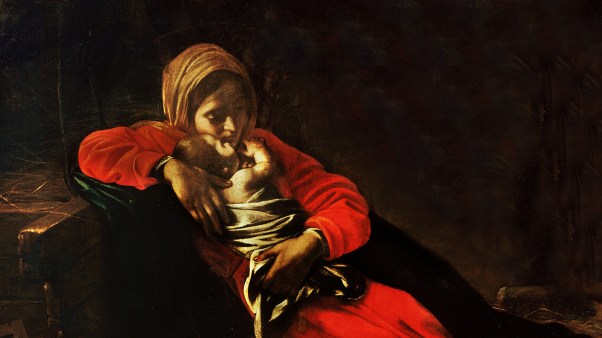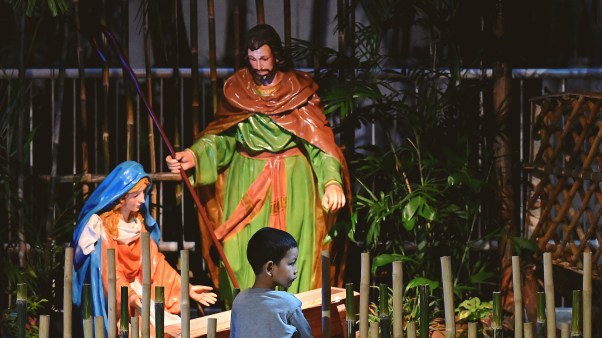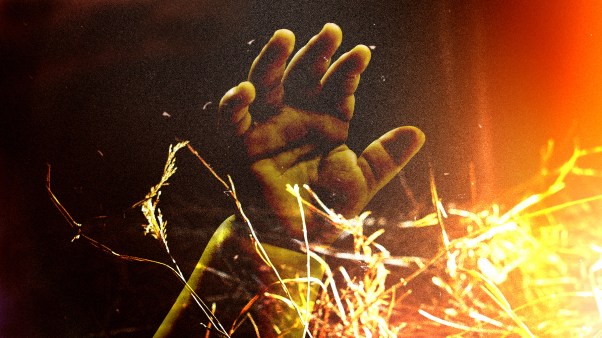On Wednesday, January 11, 1956, a Piper Cruiser PA-14 dipped slowly over the Curaray River in eastern Ecuador. Mission Aviation Fellowship (MAF) pilot Johnny Keenan leaned out the window, looking, looking. Below him squatted the stripped remains of another yellow Piper. Nothing stirred. Then, about a quarter mile downriver, he saw the khaki pants and white shirt of a young man floating face down in the water. Johnny reached for his radio.
On the other end of his call, some 50 miles away at Shell Mera, sat pilot wife, Marj Saint. She listened to Johnny’s message as three other women hovered at her side.
Late on Wednesday the body of law student-turned-missionary, Ed McCully, was identified by Quichua Indians who knew him. Unable to retrieve the body from the Curaray, they tossed McCully’s size 13 1/2 shoe on the shore and brought back his watch.
On Friday, January 13, a search party hiked and canoed their way through 25 miles of jungle to rendezvous with Ecuadorian soldiers, other Quichuas, a U.S. military officer, and Life photographer Cornell Capa. They found what was left of a dream: a few personal effects, an overturned pot of beans, and, in the water, the bodies of four young missionaries. They were World War II paratrooper Roger Youderian, budding scholar Peter Fleming, the intensely spiritual, indomitable Jim Elliot, and the imaginative, technologically creative MAF pilot Nate Saint. The search party buried the bodies just inside the jungle during a torrential downpour. Jack Shalanko, who helped, later wrote, “They were decomposed beyond recognition. Some still had spears in them.”
These men between the ages of 27 and 32 were husbands and fathers (eight children ages seven and younger among them, with one more baby due in a month). All shared a passion for taking the good news to those who had never heard the name of Jesus. “Operation Auca” was over. Or was it?
Braving the jungle
The dream had taken shape in the minds of Saint, Elliot, McCully, and Fleming. The first three had known each other at Wheaton College, where Saint had taken a year’s classes and where Elliot and McCully were campus leaders, star athletes, and notorious practical jokers. Other missionaries nicknamed them “the Brethren boys,” since all worked under the auspices of the Plymouth Brethren. In conversations together they had wondered if they might be able to make peaceful contact with an isolated and hostile indigenous group in Ecuador, then called “Aucas” (“savage” in the lowland Quichua language) and now known by the name they give themselves, “Waorani” (“the people”).
In late 1955, approximately 500 Waorani lived scattered across a territory about the size of Connecticut. Their lands were only a short plane ride from the locations where Elliot, McCully, and Saint were posted. Moving frequently and living in small clearings, the Waorani were hard for outsiders to locate. Most didn’t want to, since the Indians greeted all visitors with eight-foot-long spears. However, in September 1955, when Saint and Fleming spotted a number of Wao clearings, they thought they could use the airplane to prepare the way for peaceful ground contact.
Between October 6 and December 23, Saint, accompanied by either McCully or Elliot, made 13 flights over the Wao clearings. Fleming provided prayer and financial support from his station. Saint lowered gifts to the ground. First, they sent down an aluminum cooking pot decorated with floating ribbons, then buttons, pants, shirts (the Waorani wore only cotton G-strings), an ax head, knives, photos, machetes. The Waorani received these gifts with smiles and laughter. They began to return gifts: a headband, woven thread, smoked monkey tail, two squirrels, a parrot. During these exchanges the men shouted carefully mouthed phrases in the Wao language, which they had picked up from Dayuma, a young Wao woman who had fled tribal violence only to live in servitude at a nearby hacienda.
The seeming openness of the Waorani and favorable weather led the missionaries to consider early January for peaceful contact. A month before the launch, they added Roger Youderian, a member of the Gospel Missionary Union who had survived the Battle of the Bulge. The date was set for Tuesday, January 3, 1956. Saint ferried the other four to their designated spot some six miles from the nearest Wao clearing. “The neighbors,” two Wao women and a man, showed up on Friday, January 6. From the perspective of the five missionaries, it was a friendly visit. The Indians sampled hamburgers, and the missionaries shared their insect repellent. The man, Naenkiwi, was intrigued by the airplane, so Saint took him for a ride. The Waorani were talkative, but neither group understood the other.
Dangerous liaisons
The missionaries did not know that contact with these three Waorani had placed them in the middle of a potentially deadly conflict. Naenkiwi wanted to marry Gimari, the younger of the two women. Her brother, Nampa, objected, and the Waorani, who were engaged in vicious patterns of violence among themselves, often killed for less than this. The rage was deflected to the five missionaries. They were cowodi (“outsiders” or “cannibals”) and traditional enemies. Years later, Geketa, a member of the spearing party, gave his perspective on what happened in a film produced by the Summer Institute of Linguistics:
“One day a plane flew over us. It circled and it circled. … They dropped clothes and knives to us from the plane. Then they called, ‘Come, come, come with us.’ … A few from our group went to meet them. Later, the next night, Nampa went into a rage over a wedding he was against. Nampa … grabbed all his spears and yelled to me, ‘Come on, let’s go and kill. Just right here close by are cowodi. Remember how our mothers warned us when we were children. Cowodi have always carried guns and shot us. Now here’s our chance, let’s kill them.’ … [The next day] the plane … landed on the sandbar, then we went off with our spears to kill. The cowodi were on the sandbar calling to us. Nampa ran at one with a spear. The man shot Nampa, and the man fell right there. … We speared another, and even as they were running, I speared two more … The last cowodi called out to us. ‘Don’t spear. Don’t spear.’ And we understood. ‘We just came to meet you. We aren’t going to kill you. Why are you killing us?’ He was standing on a log jutting out of the river when Kimu ran a spear through his chest, and he fell into the water.”
Although the exact circumstances are unclear, further reconstructions of the event suggested that one missionary did fire a pistol, probably the shot that hit Nampa, who later died. The missionaries clearly offered no organized resistance, nor did any seek to save himself apart from his friends. By mid-afternoon, Sunday, January 8, it was all over. Nate Saint’s watch stopped at 3:12 p.m.
The making of heroes
The story of the five missionaries killed in Ecuador circled the globe and struck a deep chord among American evangelicals as well. During the 20th century, an estimated 26 million people around the world were killed at least in part because of their Christian faith. Most of these died relatively unnoticed. Yet these five became known, modeled, celebrated, almost beatified, so that at the 50th anniversary of their death, books and films continue to appear and many people remember. Why?
Some of the explanation rests rightly on the character of the five and their wives. They were courageous, passionately spiritual, adventurous, and acted out of concern for the well-being of the Waorani. They were willing to give their lives in order spare these people the agonies of hell—and did so.
Circumstances seemed united to appeal to the masses. The men with their wives and children embodied all that post-war Americans hoped for their own families. New worldwide communication sustained public attention in the first decade where such instant story-telling was possible. Quito missionary radio station HCJB carried the unfolding story via short wave. Life magazine sent photographer Cornell Capa to the scene. Reader’s Digest picked up the story including journal notes by the men. Elisabeth Elliot’s Through Gates of Splendor became a best seller. Magazine articles profiled the commitment of the wives as four of them remained to continue in missionary service.
For people searching for meaning in a world caught up in Cold War fears, this eternal perspective on life held greatappeal. As historian Dana Robert has commented of other missionary heroes or heroines, in death the five men became more important as missionaries to their homeland than they were able to be to the Waorani. Over the years, many have pointed to the deaths as influential in their conversion or their call to the mission field.
“On behalf of Jesus, do not spear.”
What happened to the Waorani? Before the men’s deaths, the Wao woman Dayuma had worked as a language informant for Rachel Saint, Nate’s older sister. Rachel served with the Summer Institute of Linguistics (SIL). Dayuma opened the way for Rachel and Jim Elliot’s widow, Elisabeth, to make peaceful contact with Dayuma’s extended family, including the men who had speared their loved ones.
The Waorani had experienced more than six decades of violent and bloody revenge killings among themselves. More than 60 percent of the deaths during this period were violent, making the Waorani one of the most violent cultures on earth, according to anthropologists James Yost and James S. Boster. In Wao culture, Rachel and Elisabeth should have sought revenge. When instead they spoke of God, they offered the Waorani a way to end the cycle of violence.
Over the next 20 years, this happened. Most Waorani no longer live in fear of spearings, although in 1987, two Catholic missionaries were killed by warriors from an isolated group of Waorani, and as recently as 2003, there was a tragic outbreak of intra-tribal violence.
Elisabeth Elliot left the Waorani in December 1961. Except for about five years, Rachel Saint lived among the people until her death in 1994. She began the translation of the New Testament into the Wao language, completed by SIL staff members Catherine Peeke and Rosi Jung. Anthroplogist Yost and literacy coordinator Pat Kelley also learned the difficult Wao language and spent extended periods with the people during the 1970s and 1980s. Nate Saint’s eldest son, Steve, and his family lived among the Waorani for a year in 1995. All have tried to model what it means to be Christian, though there has been controversy over the years about their and other missionary involvement.
The Waorani themselves, who number about 2,000 today, have faced numerous challenges brought by increasing encounters with the outside world. Some have rejected Christianity as they understand it, others have accepted the limited version of “thou shalt not kill,” and still others are seeking a vital, meaningful faith based on their understanding of God’s Word.
But the seed has been planted, and there are Waorani who live the faith for which, a half-century ago, the five missionaries died.
Kathryn Long is associate professor of history at Wheaton College and is writing a book on the history of the Waorani/missionary contact. Carolyn Nystrom is a freelance writer living in St. Charles, IL.
Copyright © 2006 Christianity Today. Click for reprint information.
Related Elsewhere:
Christianity Today also covered the anniversary of the martyrdom.
Out Cast: The Chad Allen Controversy
The Wrong End of the Spear | Is Christian passion for purity blinding us to our missionary impulse? (Feb. 08, 2006)
Out Cast: The Chad Allen Controversy
‘I Feel Betrayed’ | A son-in-law of one of the murdered missionaries says the casting was a mistake. (Feb. 08, 2006)
Readers Affirm Decision to Hire Gay Actor | Most Christianity Today Movies readers say End of the Spear’s filmmakers were right to honor their commitment once they had offered the lead role to Chad Allen, a homosexual. (Feb. 1, 2006)
Christian Studio Explains Hiring of Gay Actor | The makers of End of the Spear didn’t find out about co-star Chad Allen’s homosexuality until after they offered him the job, and then they felt obliged to honor the contract. (Jan. 26, 2006)
Reviews: End of the Spear The story has been told in Christian circles for 50 years. In 1956, five missionaries were brutally murdered in the Ecuadorian jungle by members of the Waodani tribe they went to serve. And then something amazing happened; the killers became Christians. (Jan. 20, 2006)
Death Worked Backwards | End of the Spear, a new film about the 1956 missionary martyrs in Ecuador, is similar to the Narnia story in some ways, says Steve Saint, son of one of the murdered men. (Jan. 18, 2006)
The Rest of the Story | Half a century after killing five missionaries, the ‘Auca’ find themselves on the cutting edge of modern missions. (Jan. 18, 2006)
End of the Spear Big Winner at Heartland | Film about 1956 missionary martyrs in Ecuador wins Film Festival’s $50,000 Grand Prize; others also lauded at Crystal Heart Awards Ceremony. (Oct. 17, 2005)
More Christian history, including a list of events that occurred this week in the church’s past, is available at ChristianHistory.net. Subscriptions to the quarterly print magazine Christian History & Biography are also available.
Previous Christian History Corners include:
Physicians of the Soul | J. I. Packer discusses the English Puritans, their quest for holiness, and why they are still worth remembering. (Feb. 24, 2006)
Blessing the Church with its History | Douglas Sweeney argues for an evangelical movement that welcomes diversity and repents of its blind spots. (Feb. 10, 2006)
Erasmus’s Revolutionary ‘Study Bible’ | The spiritual father of so many English Reformers died at the hands of the church he refused to leave. (Jan. 13, 2006)
Campus Ministry Cambridge Style | The roots of InterVarsity and other evangelical college clubs (Jan. 6, 2006)
Dorothy Sayers: “The Dogma Is the Drama” | An interview with Barbara Reynolds. (Dec. 16, 2005)
Sharing Stories from the Heart | The lessons of history are fair game for use today. (Dec. 9, 2005)
Eat, Drink, and Relax | Think the Pilgrims would frown on today’s football-tossing, turkey-gobbling Thanksgiving festivities? Maybe not. (Nov. 18, 2005)








